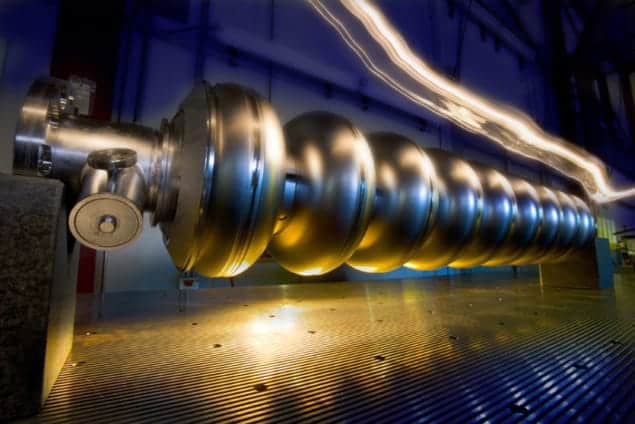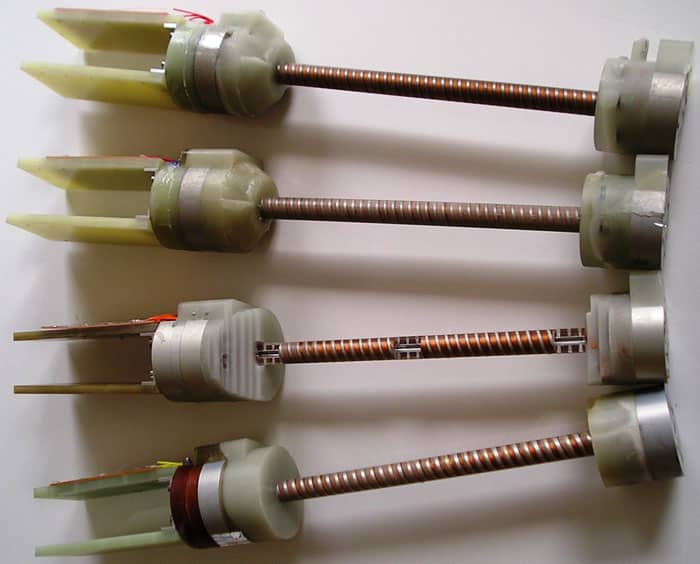
A full-scale undulator module that could produce the intense positron beams needed for next-generation particle colliders has been unveiled by an international team of physicists. Similar modules could be used in future projects such as the International Linear Collider (ILC) and the Compact Linear Collider (CLIC) – both of which aim to collide high-energy positrons with high-energy electrons.
Future collider projects such as the ILC and CLIC will need stable positron sources that are about 60 times more intense than those available today. In addition, these sources must produce positrons that are spin aligned and circularly polarized. Now a team led by Jim Clarke of the UK’s Daresbury Laboratory has developed an undulator that the researchers say fits the bill. The work involved the evaluation of many different designs – both by doing computer simulations and by building small-scale prototypes.
An undulator contains magnets that force an electron beam to follow a specific trajectory, causing the electrons to emit gamma-ray photons. These gamma rays are then used to produce an intense positron beam. “In our design we create a helical magnetic field by using a double helix of superconducting wires, with current flowing in opposite directions in each helix. An electron moves in a helical trajectory through the helical magnetic field. If viewed end-on, the helical trajectory appears as if the electron is describing a circle, hence the emitted radiation is circularly polarized,” says one of the team members, Duncan Scott.
Minimizing leaking heat
Scott explains that one of the main ways of achieving the high efficiency involved locating and minimizing heat leakage in the system. “We designed the system to operate at 80% of the maximum load, but after extensive tests and redesigning some parts we managed to get that down to 70%,” says Scott.
In the ILC, the electron beam that passes through the undulator will then go on to be used in the main electron–positron collisions – so it is crucial that the electron beam is not disrupted by the undulator. While the researchers have not yet tested their device with an actual electron beam, Scott says that a large number of simulations were carried out to ensure that the final beam is stable. “There was a genuine concern that steering this high-quality beam 200 m through a vessel 6 mm in diameter would disrupt the electron beam quality too much,” says Scott. He compares this disruption – which is caused by the electric field of the beam interacting with the vacuum vessel and then feeding back on the beam – to the wake left behind a boat moving through a canal that is then reflected off the canal walls and interacts with the original wake.
“Our work showed that we had to use an extremely smooth copper pipe, with a surface roughness of about 100 nm. In addition, the alignment of each of the 4 m modules [there are 60 in total] has to be accurate to within 300 µm. This is a challenge, but we have a suitably smooth vessel and we believe we can meet the alignment requirements,” explains Scott.
With data from their simulations and studies, the researchers report that the gamma rays generated by their device will be capable of producing about 1010 positrons per electron pulse – the ILC specification – even when the current in the superconducting wires is only 70% of the maximum. This means that the ILC will require about 120 of these undulators lined up in series to generate sufficient gamma rays.
Major hurdle overcome
Scott also points out that producing “a fully working proof-of-principal device that shows we can generate the required number of photons” involved overcoming a major technical hurdle, as was proving to the particle physics community that the device “won’t disrupt the beam quality, short of testing it with the real beam”, both of which the researchers have now accomplished.
In the coming months the team will be looking at passing a real electron beam through the device magnet and measuring the radiation output. The researchers are also currently in discussions with the Argonne National Laboratory in the USA about sending the undulator over to be installed on the electron test beam there. Although it will still be many years before the device is used in the ILC or CLIC, Scott feels that the best thing that physicists designing such machines can do in the meantime is to “clearly demonstrate we know how to build key components such as this undulator”.
Scott also points out that while the undulator would be essential for the ILC and CLIC, similar superconducting undulators are also used in synchrotron light sources and free-electron laser.
The work is described in Physical Review Letters.




